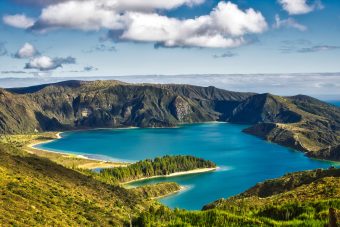
“There is no pathway to limiting global warming to 1.5C without action on protecting and restoring nature,” wrote four architects of the Paris Agreement ahead of the COP15 UN biodiversity conference last December. “Achieving net-zero emissions by 2050 is only possible if we act now to deliver a nature-positive society.”
Building a nature-positive world and scaling up climate finance flows by at least 590 percent to meet the 2030 global climate goals will require an immense mobilization of resources. Blended finance will be a particularly important source of finance for nature by using public or philanthropic funds to catalyze private investment. Blended finance is also key for bridging the 700 billion dollars per year biodiversity financing gap.
The Kunming-Montreal Global Biodiversity Framework (GBF) takes significant steps to scale financing for nature as it seeks to halt and reverse biodiversity loss and put nature on a path to recovery. Conservation International’s Exponential Roadmap for Natural Climate Solutions outlines a path to reach net-zero emissions from the land sector by 2030 through natural climate solutions that protect existing ecosystems, sustainably manage working lands and restore degraded forests and wetlands but getting there will require seismic changes in global finance, even for “cost-effective” mitigations solutions costing less than 100 dollars per ton.
Therefore, it is important to put in place the enabling conditions for blended finance to scale up quickly.
More:
- ONCE THREATENED, MEXICO’S “GREEN JEWEL” HAS BECOME A MODEL OF CONSERVATION
- EXTREME WEATHER IS THE “NEW NORM”
- WHY RESTORING NATURE IS GOOD FOR FARMERS, FISHERIES AND FOOD SECURITY
Scaling finance through diverse coalitions
First, we must build ambitious coalitions to finance key biodiversity areas. Leveraging ambitious coalitions between the Global North and the Global South by partnering with different kinds of international entities will be critical to accelerate action and scale up financing toward the common goal of protecting nature. The G17 (the world’s 17 megadiverse countries) will likely be able to effect greater influence than any of the individual countries on their own.

The Global Fund for Coral Reefs (GFCR) is a coalition of UN Agencies, nations, philanthropies, private investors and organizations meant to address the threat of global temperature rise to the world’s remaining coral reef populations. This blended finance instrument is a 10-year, 625 dollars million vehicle meant to “supercharge” conservation efforts to protect vulnerable coral ecosystems – a powerful example of the impact that can be achieved in coalition.
Working in a coalition is also key to ensuring no one gets left behind. Indigenous peoples represent only six percent of the global population but protect 80 percent of global biodiversity. A recent Conservation International paper on drivers that reverse deforestation trends shows that indigenous-led management is key to slowing deforestation. Despite their role as custodians of nature, Indigenous peoples and local communities (IPLCs) receive very little global environmental finance.
Coalition building – with actors who prioritize IPLC involvement – will help redirect finance flows to community-led conservation efforts. According to the World Economic Forum report, embedding traditional ecological knowledge and empowering Indigenous peoples as co-investment leaders in nature-based solutions brings value to both corporate action on nature and the long-term health of nature.
Mainstreaming nature across multilateral development banks
Second, nature considerations must be mainstreamed across the operations and policies of multilateral development banks (MDBs) to scale up blended finance. Making MDBs fit for purpose to address the interconnected crises facing the Global South this century has been an international priority following the publication of the Bridgetown Initiative and the Summit for a Global Financing Pact, which took place last June.

Last year’s COP15 decision also calls upon MDBs and other international financial institutions to be engaged in the design and operationalization of the Global Environment Facility’s (GEF) GBF Fund.
We’ve already seen the difference MDBs can make when leading in developing blended finance instruments. The World Bank’s Wildlife Conservation Bond (WCB) is a 150 million dollars outcome-based bond that leverages grant-based financing from the GEF with private investments to protect endangered black rhino populations, tying investors’ returns to rhino growth rates. The GFCR draws on various MDBs and the Green Climate Fund to help unlock coral reef adaptation financing.
Strong foundations
Third, insulating climate and biodiversity finance from the swing of the political and economic pendulum is key. Elections can bring changes in political will to fund nature in response to the twin biodiversity and climate crises. Economic downturns and shrinking corporate budgets often impact sustainability investment. Strong national policies with standardized tools and processes must be institutionalized to unlock funding for nature consistently.
Funding mechanisms can also be structured to be resilient. The GFCR draws funding from diverse stakeholders, including commitments from the governments of Germany, Canada, France and the UK. Collaborating with multiple member states, multilateral institutions and the private sector makes the GFCR less reliant on a single actor and more resilient to shifts in national politics.
These daunting challenges to bridge the climate finance and biodiversity funding gaps present a golden opportunity for blended finance and other innovative mechanisms to catalyze public, private and philanthropic investments. These three enabling conditions will help unlock blended finance’s potential to meet 2030 climate and biodiversity targets.
Source: World Economic Forum



